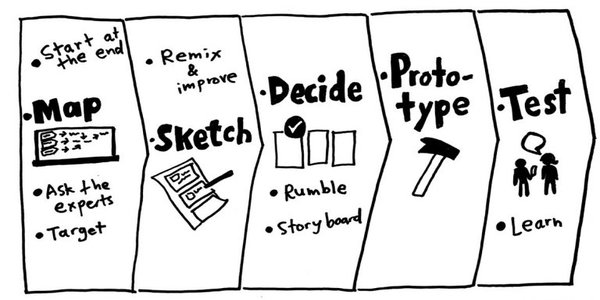
First of all, what is a design sprint? The sprint methodology was created by Jake Knapp at Google Ventures. By following this methodology, you will work for 5 days to solve a big problem. Each day, you go through a series of exercises developed to guide you to achieve the main goal for the day. You need the apparatus (mainly post-its, sharpies, a whiteboard and a timer). Then, during the sprint the facilitator needs to keep an eye on the timer, instruct the team to do the exercises, keep the energy level up, and if the facilitator is experienced enough and feels like it, they can even take part in the sprint. After the sprint, there is a deep reflection on the sprint and analysis of the data collected by the test, so the team can learn and plan the next steps. And of course, let’s not forget iteration. You can jump right into an Iteration Sprint, which is a sprint you work on small adjustments to the previous creation in order to retest, if need be.
Are you an educator? This sounds very familiar, right? Most probably something you have already been doing on a daily basis, probably for years – but not called it design sprint. As educators, whenever planning the lessons, you normally go through a similar checklist: find a challenge, or learning objective, set the space, think about time, prep the team (students), rehearse instructions, check for classroom apparatus, sometimes take part in the lesson while guiding them during the exercise, reflection, feedback, learning, planning next steps, repeat.
So where is the difference between the two settings, then? Most probably in how much less work for preparation and execution a facilitator needs than an educator. In more traditional classrooms, teachers are responsible for learning all they can about the subject and passing it along to students who passively take it all in, absorbing whatever they can to get a good grade on the test. This model of teaching and learning no longer applies to our modern learning style.
So, here are 4 main reasons why you should adopt a sprint mindset in education today:
- Innovation: Design sprints are a great way to innovate and lead a learner-centered experience. If you compare a classical education setting today to a design sprint war room, you will notice they are pretty similar: both follow a structured methodology with step by step procedures that result in finding a solution to a big problem in a fast and creative way. Both need a facilitator, one person who will manage time, conversations and the overall process. Sprints and classrooms both focus on a single outcome; time restraint does not allow you to waste too much time working on a solution; you work together with a team, but the end result might be different for each member of the team.
- Skills: Sprints go beyond just solving a big problem. It is an exercise of collaboration, communicating your ideas to the team, unbiased arguments, decision-making and critical thinking, and most importantly, creativity. These are all skills you need in real life. By using sprint in education, you will be providing a meaningful and real learning experience for the students.
- Educators’ experience: We just spoke about the students, but there are also the educators. What about them? Also they are facing challenging in the learning process, at times not knowing hot to facilitate learning, at other times clinging tightly to a traditional and outdated way of teaching. What should we do to help them and have them fun along the learning process as well? Well, sprint them up! And besides that, educators can have a chance to be part of the creative process, develop their own social and emotional skills, learn and have fun, all the while facilitating the process and managing the class.
- Failing required: Getting started is more important than being right: this is one of the principles of a design sprint. What does this mean? That there is no right or wrong when it comes to creative problem solving. The main focus is always to validate a hypothesis and that can be done in different ways. Failing actually might be even the better way if thanks to that you can steer the entire project in the right direction at an early stage. Nevertheless, failures and mistakes, although we always speak of learning, have a negative connotation. This can be reversed if we create a safe environment for learning, and actually welcome failures as it happens during a sprint.

